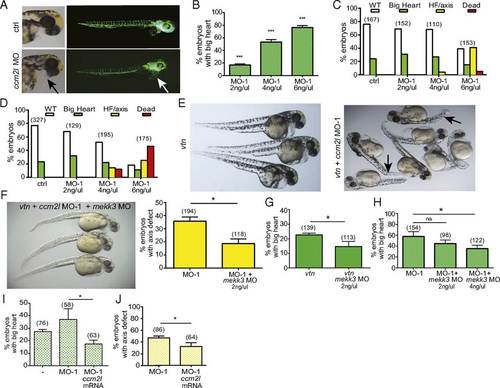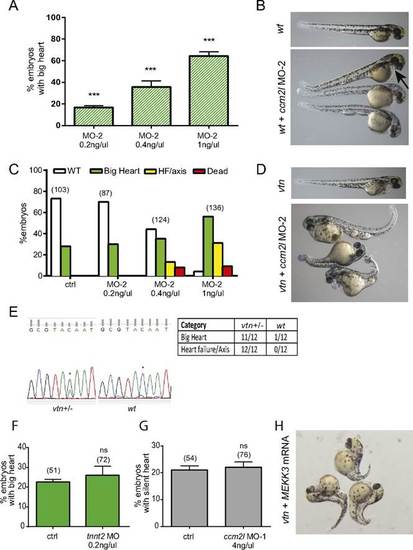- Title
-
The cerebral cavernous malformation proteins CCM2L and CCM2 prevent the activation of the MAP kinase MEKK3
- Authors
- Cullere, X., Plovie, E., Bennett, P.M., MacRae, C.A., Mayadas, T.N.
- Source
- Full text @ Proc. Natl. Acad. Sci. USA
|
Genetic interaction of ccm2l with ccm1 and ccm2 and modulation of mekk3 activity in zebrafish. (A) Single-cell flk-GFP embryos were injected with control (ctrl) or ccm2l MO (MO-1), and images were obtained at 48 h postfertilization. The arrow indicates cardiac enlargement/big heart. (B) The big heart phenotype was evaluated with increasing doses of ccm2l MO-1. (C–E) Different amounts of ccm2l MO-1 or ctrl MO were injected into embryos from san/ccm1 (C) and vtn/ccm2 (D) heterozygous crosses. The vtn/ccm2 zebrafish with ccm2l knockdown show further enlargement of the heart in combination with heart failure (HF) and tail/axis defects (arrows). Phenotypes were classified as WT (no phenotype), big heart, HF/axis (HF and axis/tail defects), or dead (lack of survival). (E) Representative pictures of vtn/ccm2 mutants without (Left) or with ccm2l MO-1 injected (Right). (F) Rescue of the axis phenotype in ccm2/ccm2l-deficient fish with 4 ng/µL mekk3 MO. Embryos from vtn/ccm2 heterozygous crosses were injected with ccm2l alone or in combination with ctrl or mekk3 MO, and the axis defect phenotype was scored. (G) Rescue of the big heart phenotype in vtn/ccm2 mutant fish (vtn) with ctrl or 2 ng/µL mekk3 MO. (H) Rescue of big heart in WT plus 4 ng/µL ccm2l MO-1 injection with ctrl MO or indicated concentrations of mekk3 MO. (I and J) Rescue of big heart (I) and tail axis defects (J) in vtn + ccm2l MO-1 zebrafish, with human CCM2L mRNA. The big heart phenotype in vtn alone (I, ) is shown for comparison. *P < 0.05, unpaired t test. Graphs represent data pooled from three independent experiments. Error bars represent SEM. PHENOTYPE:
|
|
(A) Dose–response curve of ccm2l MO-2 injected into embryos from WT. ***P < 0.005, ANOVA. (B) Representative pictures of WT embryos (Upper) with and without ccm2l MO-2 (Lower). The arrow indicates big heart. (C and D) Injection of MO-2 in vtn/ccm2 heterozygous crosses results in heart failure and severe tail/axis defects. Quantitation of phenotypes in C: WT, no phenotype; big heart; HF/axis, heart failure and axis/tail defects; dead, lack of survival. Representative images are shown in D. (E) Genotyping. Chromatograms representing sequence results from vtn heterozygous crosses injected with ccm2l MO-1 (Upper). vtn heterozygous embryos show a double peak (C and A, asterisks), inferring the presence of a vtn (A) and an ortholog WT (C) gene, whereas WT controls show a single peak (C). vtn homozygous embryos were not detected in the surviving embryos in this cross, which may reflect lower survival rates in this group after ccm2l MO injection (Fig. 2D). (F and G) Injections of a cardiac-specific MO (troponinT, tnnt2) in vtn mutants (F) and ccm2l MO-1 injections in silent heart mutant (G) did not phenocopy the ccm2l MO-1 axis defect results (ns, not significant, unpaired t test). Graphs represent data pooled from three independent experiments. The number of embryos scored is in parentheses. Error bars represent SEM. (H) Representative picture of mekk3 mRNA-injected vtn/ccm2 embryos showing more severe tail axis defects and cardiac failure. PHENOTYPE:
|


